Nocking Points & D Loops. How To Set Them Up On Your Bowstring.

Whether you use a longbow, recurve, or compound bow, accuracy in archery is vital.
Although simple pieces of equipment, the archer would be inconsistent in their shooting without a good nocking point, or secured d loop.
There are dozens of variations of how to set up your nocking point. Like with brass nock sets, tied nock sets and the use of the d loop, etc.
Some of the bowstring set ups are more suited for a compound bow, such as using a d loop.
In this article we will cover some standard and variations of nocking point and d loop styles and set ups. As well as some positives and negatives of each style.
Archery terms.
Because it can get a bit confusing talking about nocks, nock sets, nocking points, here are some terms. Please note, some terms are interchangeable and have multiple meanings.
Arrow nock – The arrow nock goes on the end of the arrow.
Nock set – Also might be called a noc set, string nock or nocking point. This goes on the bowstring and helps position the arrow.
It might be a round piece of brass or metal that crimps on the bowstring. It might also mean a tied on piece of thread on the bowstring for placing the arrow.
Nocking point – It can mean the metal nock set component. Or the actual the position on the string where it goes.
Nocking the arrow – Placing the arrow on the bowstring.
Nocking points and d loops. Different set ups.
The d loop by itself.
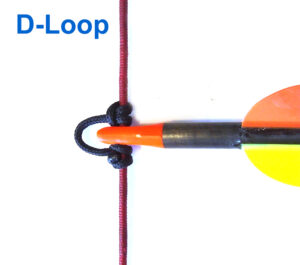
The d loop is very popular with compound target archers and bowhunters alike who use a release aid device.
The d loop normally pulls equally above and below the arrow nock and shaft.
It delivers the bow string’s force more uniformly to the end of the arrow shaft. There is no downward flex on the arrow and arrow rest, or sideward pressure as with finger shooters, therefore it should increase accuracy and speed.
There is also less wear on the bow string serving as the release aid is not directly contacting the bowstring.
Archers with a very long draw length may be limited with archery bow brands and makes, as some don’t cater for very long draw lengths. While not increasing the bow’s draw length, it can help increase the archers anchor point for very tall archers or long limbed shooters.
Tip – You don’t need a pair of d loop pliers which help tighten the d loop on the bow string. Just use your release aid device to clip on the loop and pull firmly. Don’t draw the bow back fully though. As you might accidently release the bowstring and dry-fire the bow. Or the d loop might slip.
Cons – The d loop is harder to hook up quickly with the archery release aid or under pressure.
More additional equipment to fail or complicate things. May slip up without additional nock sets to hold it securely.
The d loop may affect your anchor point.
While the bows draw length technically stays the same with a d loop on it, the archers anchor point may be half an inch or so longer. If you do shorten your bow’s draw length to compensate for the added d loop length on your anchor point, you will lose some arrow speed.
To learn how to install a d loop click on, How To Tie A D Loop
Single metal nock set.
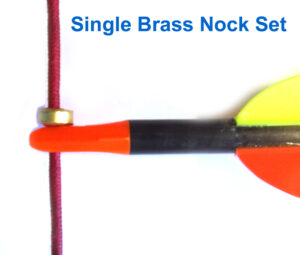
For finger shooters and release aid shooters, the single brass nock set, or metal nock set is easy to install with nocking pliers.
It nock set won’t slip with correct installation and is relatively easy to uninstall or move for tuning.
This set up has been standard for many longbow and recurve archers over the years because of the simplicity and reliability.
Cons – More weight than a tied in nock set. The arrow can slide down the bowstring.
Direct wear from release aid jaws if used on the bow string. The jaws may also put pressure on the arrow nock and pinch it or push the arrow off the bow string.
Double metal nocking points.

Two metal nock sets provide a secure nocking point. It can be used with a release aid or for finger shooters.
The advantage of one noc set below and above the arrow is, the arrow won’t slip down upon release.
Cons – More weight than a single one.
For bowhunters looking at game, not at their equipment, it may be a touch harder to nock the arrow in position while not looking at it.
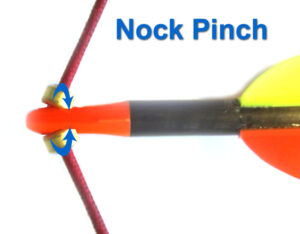
If the two noc sets are placed too close to each other, they will pinch the arrow nock.
Single tied nock set.

Tied nock sets points (Also called soft nocks.) are light weight on the bow string and stay in position if tied in firmly.
They can be used for release aid archers and are great with target finger shooters, as the minimal size profile releases a touch better than the metal nock set.
The softer material can cause less wear on finger tabs or a shooting glove then a brass noc.
A tied on nock can also be lighter than a metal nock set.
Tied noc sets can be made out of dental floss, cotton thread, BCY nock tying thread, #3D serving or similar.
Cons – Harder to put on, adjust or remove. For the bowhunter using fingers, it may wear more than a brass nock set.
Double tied nock set.

The two points stop the arrow sliding down and positions the arrow consistently on the bowstring.
This is a favorite for some serious finger shooters and Olympic recurve target archers.
Two tied in nocking points if used with a release aid device shooters will also will stop the metal jaws from directly touching the arrow nock.
Cons – A touch more weight than one nock set and more time to fix and adjust.
D loop with one tied nock set.
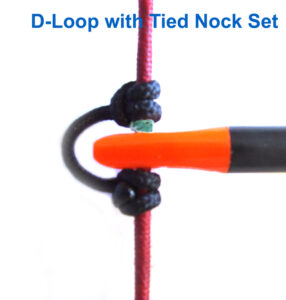
The single tied nock set with a d loop may give you the best of both worlds for a compound shooter. As it secures the arrow and the d loop won’t slip.
Cons – Slightly more weight and fiddley to tie it in between the d loop.
D loop with two tied nock sets.

The double tied nock sets with a d loop is popular with some target archers. As the d loop can put some downward pressure on the arrow when the bow is at full draw.
A double set up, helps it stay on the arrow rest, which is handy for bowhunting or field archery shooting different angles.
If your d loop breaks or for replacing worn d loops, this system is great as your nocking points are already there.
Cons – Takes more time to tie it in and slightly more weight, although string nock sets have minimal weight.
D loop with metal nock set.
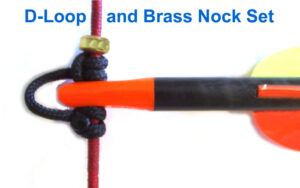
A single brass or metal nock set place above the d loop gives a solid knocking point that won’t slip and is easy to install.
Cons – More additional weight and bulk.
Metal nock set between the d loop.

A single metal nock set placed between the d loop, gives a similar advantage as above. But you have a more accurate reference point if your d loop breaks, or you have to replace it.
Cons – May pinch into plastic arrow nock and more additional weight.
Eliminator buttons.
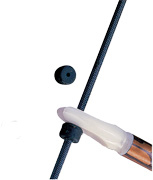
An eliminator button is basically a rubber nock that goes between the release aid and arrow nock. It cushions the arrow nock from the release aid.
It can be used with a brass or string nock set above the arrow nock, or d loop.
Cons – Some require that the bowstring be taken off to be slid on.
The eliminator button can crack or pop off, depending on manufacturer. From my experience a lot of eliminator buttons wear very quickly and may or may not be worth the effort.
Metal d loops
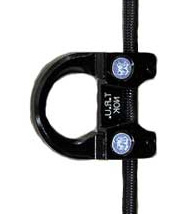
Some metal d loops have the advantage of helping align the peep sight as the arrow nock aligns in a slot, which eliminates the rubber tubing of some peep sights.
Metal d loops are also reasonable easy to fit and adjust.
Cons – On paper, metal d loops look like they have a few advantages. However, in reality metal d loops have a lot of drawbacks.
More weight on the bow string then a cord d loop. Also they may be harsh on release aid jaws, from the metal contacting each other and can make more noise.
The metal loop isn’t as forgiving as the string d loop material.
Some brands are poorly constructed and the small screws required to secure it, may break easy.
Tape on the bowstring for a children’s bow.
If you are a beginner in archery, even a bit of electrical tape might work on the bow string.
Cut it so it is about ¼ inch wide (About 6 mm.) and wrap it on the string place. Locate it just above the horizontal arrow on the bow string.
A tied on noc set would be a better option, but for a makeshift nock set on a children’s bow, it will work.
Are nocking points necessary?
Yes, nocking points are necessary. A solid knocking point, whether it be a brass noc set, a secure d loop, or a tied on nocking point, help place the arrow on the bowstring in a consistent spot.
This consistency helps accuracy.
Without a proper nocking point, the arrow may be placed on the string in a different spot each time.
Also when at full draw and during the arrow can slide up or down the bowstring during release causing inconsistent results.
Where should my nocking point be?
Use a bow square or “T” square to help set the height.
Be mindful that some archers will talk about high the actual nocking point is from 90 degrees of the arrow rest. (The top of the arrow nock will touch the bottom of the nocking point.) Others are talking about how high the bottom of the arrow is above 90 degrees.
In this article we will use how high the nocking point is located on the bowstring above the arrow rest or shelf.
Your arrow should sit on the bowstring from slightly above 90 degrees, to very high above it.
This exact location on the bowstring will depend on a lot of factors. Arrow diameter, arrow nock size, shooting style, bow tiller, bow type, single cam, double cam, arrow rest, arrow spine, etc.
Here are some starting points:
For compound archers using a d loop and release aid, the knocking point might be set at about ¼ inch (About 6mm.) above square. Some compound shooters will have their arrow set 90 degrees flat from the string.
For recurve and longbow finger shooters, position the nocking point around ½ inch (About 12mm.) above the arrow rest or shelf.
For three finger under shooters, this might even be as high as ¾ of an inch above the rest.
Once again these heights are a rough guide and will depend on a lot of factors. Bow tuning will get you the answer for the correct height where you nocking point should be located.
Tip – I normally pull the arrow nock out of the shaft and place it on the string for tying d loops on. This is easier than struggling with a long arrow on the bowstring.
The Easton Archery tuning guide, is the bible when it comes to setting up and tuning bows.
How do you attach brass noc sets on the bow string?
Ideally use a pair of nocking pliers. These proper pliers help give an even pressure around the noc set when squeezing it.
I have used normal pliers before to squash down the brass noc set. However it doesn’t give a nice round crimp around the brass noc.
You have to be careful that you don’t squash and damage the bow string with normal pliers.
Easton Archery has a good set, which are also a pair of pointy nose pliers. Also you can use the back of them to help tighten the d loop.
How to take a noc set off?
On the pair of nocking pliers, most models will have an edge that can help pry the crimp open.
If you haven’t got a set, be very careful that you don’t damage the bow string.
I have carefully used a butter knife before to gently prize open the bras noc. But never do it forcefully, or with anything sharp.
Buying a pair of nocking pliers is cheaper than replacing a damaged quality bow string.
Conclusion – Nocking points and d loops. How to set them up on your bowstring.
There are countless other d loop and nocking point set ups, each with their own pros and cons.
For 3D, field and target archery, there is generally a good reason why the top performers choose their nocking point set up.
For bowhunters, a simple system works best. As Murphy’s Law sometimes steps in when it comes to your archery equipment in the field.
Try a few different set ups and see which style suits your shooting!
